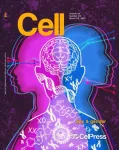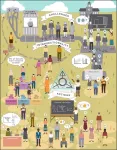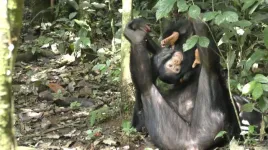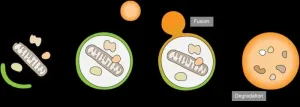(Press-News.org) Cell, the flagship biology journal of Cell Press, presents a landmark issue on sex and gender in science. It includes a collection of articles on topics related to strategies for promoting gender equality in academia, enhancing rigor in the study of sex-related variables, and supporting transgender researchers. The special content, scheduled to appear online on March 14, 2024, also discusses the past, present, and future of research on sex and gender.
To mark the occasion, Cell Press’s parent company, Elsevier, is announcing updated guidelines on reporting sex- and gender-based analyses (SGBA), inspired by the Sex and Gender Equity in Research (SAGER) guidelines, which were implemented across all Cell Press and Lancet journals, and nearly 2,300 Elsevier journals in 2023.
Elsevier’s SGBA guidelines support equitable and impactful science by encouraging researchers to use precise language and definitions in their work, ensure samples are sufficiently representative and inclusive to support robust conclusions, and avoid inappropriate generalizations. For example, study authors are asked to use more precise terms like “sex assigned at birth” over vague and ambiguous ones, like “biological sex."
“Discussions that steer us away from outmoded binary notions of sex and gender are much needed,” says Isabel Goldman, MD, a Cell Leading Edge editor and Cell Press’s previous diversity equity and inclusion lead. “In the span of a year, our journals’ information for authors went from containing disparate, little, or no information on sex and gender to presenting unified state-of-the-art guidelines across thousands of titles.”
Included in the Cell focus issue:
Rigorous science demands support of transgender scientists
This landmark commentary from 24 transgender (and/or family members of trans) scientists explores the experiences of sex and gender minorities in STEMM and why addressing systemic barriers that they face will lead not only to just, equitable, and diverse research departments, but also to more rigorous science. “When cis and trans people alike challenge sex and gender essentialism, we enshrine bodily autonomy and intellectual freedom. When we build institutions and systems to support all who contribute, we move to rectify scientific inequity and injustice,” write the authors.
Sex contextualism in laboratory research: Enhancing rigor and precision in the study of sex-related variables
This perspective article documents how the first step toward better understanding sex-related variation in health and disease is to acknowledge that sex per se is not a biological variable or causal mechanism. Instead, it is a “classification system” with categories that encompass an array of varying and overlapping traits. The authors urge researchers to move “beyond sex as a system of classification” and toward “working with concrete and measurable sex-related variables” and to employ rigorous sex-based analyses to support robust research conclusions.
The history of sex research: Is "sex" a useful category?
This Benchmark explore the multiplicity of sex definitions throughout the history of sex-based research, which has caused it to mean “just about everything, and therefore also nearly nothing,” writes author Beans Velocci, PhD, an assistant professor of history and sociology of science at the University of Pennsylvania. As such, the term “sex” often functions as a binary, categorical variable that captures many distinct traits and characteristics. It has functioned historically to uphold social systems. Dr. Velocci argues that improving sex and gender research will require a cross-disciplinary approach.
Closing the scissor-shaped curve: Strategies to promote gender equality in academia
Institutional gender inequality manifests as a “progressive decline in the representation of women at successive stages of the scientific and academic career trajectory,” write researchers at the University of Lausanne in this commentary. The authors examine data-driven initiatives related to hiring, mentoring, funding, culture, and maternity leave that they have implemented at their university to combat the scissor-shaped curve in STEMM, which sees men many more times likely to attain full professorship than women.
Q&As with Shirin Heidari and Londa Schiebinger
The focus issue features two exclusive researcher interviews. The first is with the lead author of the SAGER guidelines, Shirin Heidari, PhD, who discusses her work and the importance of considering sex- and gender-related variables in science. The second conversation is with Londa Schiebinger, PhD, founding director of the Gendered Innovations in Science, Health & Medicine, Engineering, and Environment project, on the persistent STEMM gender gap.
The future of sex and gender in research
In this Voices article, eight scientists talk about interdisciplinary collaboration, moving beyond binary conceptualizations, and expanding research on sex-related differences and sex’s dynamic nature. “Science’s rigid commitment to binary sex and gender quashes creativity and limits progress.” says Elle Lett, PhD. “What if, instead, we imagined a world where society’s baggage didn’t encumber scientific conceptualization?”
###
Cell (@CellCellPress), the flagship journal of Cell Press, is a bimonthly journal that publishes findings of unusual significance in any area of experimental biology, including but not limited to cell biology, molecular biology, neuroscience, immunology, virology and microbiology, cancer, human genetics, systems biology, signaling, and disease mechanisms and therapeutics. Visit: http://www.cell.com/cell. To receive Cell Press media alerts, contact press@cell.com.
END
A group of 24 transgender (and/or family members of transgender) scientists describe what it’s like to be a transgender person in STEMM. In a commentary publishing on March 14 in the journal Cell, they discuss the historical origins of trans marginalization, explain how this affects trans people’s careers in science and medicine, and lay out actions that cisgender individuals and institutions can take to support trans people in STEMM.
This first-of-its-kind commentary appears in a sex and gender focus issue of Cell, covering topics such as gender equity, the history ...
Contrary to common belief, not all vertebrates regulate their sleep-wake rhythm in the same way. University of Basel researchers have discovered that some fish – unlike humans – do not need orexin to stay awake. This molecule was thought to be necessary for normal wake and sleep rhythms in vertebrates. Humans without orexin suffer from narcolepsy.
Until recently, it was assumed that vertebrates share similar mechanisms controlling sleep behavior. That's why researchers have been using fish in the past 20 years as a model organism to study sleep ...
After the egg has been fertilized by a sperm, the surrounding egg coat tightens, mechanically preventing the entry of additional sperm and the ensuing death of the embryo. This is according to a new study led by researchers at Karolinska Institutet and published in the journal Cell. The work also explains how mutations in egg coat proteins can cause female infertility and may eventually lead to new contraceptive methods.
Fertilization in mammals begins when a sperm attaches to the egg coat, a filamentous extracellular envelope that sperm must penetrate ...
About The Study: Teen pregnancy was associated with future premature mortality in this study of 2.2 million female teenagers. It should be assessed whether supports for female teenagers who experience a pregnancy can enhance the prevention of subsequent premature mortality in young and middle adulthood.
Authors: Joel G. Ray, M.D., M.Sc., of the University of Toronto, is the corresponding author.
To access the embargoed study: Visit our For The Media website at this link https://media.jamanetwork.com/
(doi:10.1001/jamanetworkopen.2024.1833)
Editor’s Note: Please see the article for additional information, including other authors, author contributions ...
About The Study: In this study of partners and adult children of stroke survivors, risks of several mental health conditions and self-harm or suicide were moderately higher compared with the general population and, to a lesser extent, partners and adult children of heart attack survivors. These findings highlight the potential consequences of stroke among family members, particularly partners, and its findings may possibly serve as a quantitative foundation for the development of future stroke rehabilitation services.
Authors: Nils Skajaa, Ph.D., of Aarhus University Hospital in Aarhus, Denmark, is the corresponding author.
To ...
When it comes to nurturing their young, mother chimpanzees go the extra mile, according to a new study. Using 10 years of observational data on wild chimpanzees, researchers found that while adults often play, and young chimps play a lot, when food gets scarce, the adults put mutual play aside and focus on survival.
But in the meantime, mother chimps continue to be their offspring’s primary playmate, tickling, chasing, playing ‘airplane’. That suggests the mother chimps take on an indispensable role ...
It’s no secret that smoking is extremely detrimental to health. Tobacco smoke contains thousands of chemicals, including carcinogens, increasing the risk of cancer, cardiovascular and respiratory diseases.
A new study from the University of Chicago analyzed data from more than 900 samples of nine different human tissue types to understand just how deep the cellular and genetic damage from smoking goes. The research team generated epigenetic data to assess the effects of smoking on DNA methylation, or genetic locations where a handful ...
The pregnancy and post-partum experience is stressful, but for pregnant adolescents the barriers to accessing supportive care can have fatal consequences.
A recent study from The Hospital for Sick Children (SickKids) identified that compared with those who had no teen pregnancy, teenagers in Ontario who experienced a pregnancy were at a 50 per cent higher risk of premature death before the age of 31. This risk was even higher for people who had two or more teen pregnancies and amongst those who were pregnant before 16 years of age.
Published in JAMA Network Open, the study also found that ...
Researchers from Tokyo Medical and Dental University (TMDU) uncover the specific protein interactions needed for cells to break down and remove damaged mitochondria
Tokyo, Japan – Autophagy is a process used by cells as a recycling system to transport and break down organelles and other cytosolic components, which become enveloped in a membrane called the autophagosome (Fig 1). When this involves the removal of damaged mitochondria, commonly called the “powerhouse” of the cell, it is known as mitophagy. In a recent article ...
Achille Mbembe is research professor of history and politics at the Wits Institute for Social and Economic Research, at the University of the Witwatersrand, Johannesburg. He will receive the award of NOK 6,000,000 (approx. EUR 525,000) during a 6 June ceremony at the University of Bergen, Norway.
Mbembe is one of the most read and cited scholars from the African continent and receives the prize for his pioneering research in African history, postcolonial studies, humanities, and social science over four decades. ...






